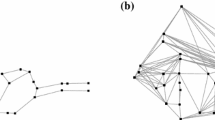Abstract
We describe two methods for the optimization of gas transmission networks. The first method reduces the number of variables in the optimization problem by eliminating the pipe-flow variables. The second method solves an optimization problem with the full set of variables to achieve better behaviour. These two methods are compared by a series of tests based on the British Gas NTS (National Transmission System). The results of these tests are reported. By formulating the network problem as an optimization problem we have been able to replace heuristics by well proven methods. The reliability of the algorithm using the reduced set of unknowns varied depending on the size of problem and the type of objective function being minimized. The algorithm using the full set of unknowns had no such difficulties, even though it needs to be used with some care. The algorithm is robust in the sense that when the objective function has the necessary continuities, there is a feasible point and the penalty terms ensure positive curvature, then a solution is found reliably. The algorithm based on the reduced set of unknowns is considerably faster than that using the full set, when it succeeds. The factor between the times taken ranges from 1.2 to 5 (average 3) for the smallest network. For the second case comparison is harder since the reduced set algorithm was given a head start in five cases. For the other five the factor is between 2.3 and 8.3. For the largest problem there is just one case in which the comparison is on equal terms, and here the factor is 18. It is clear that the reliability of the full set algorithm is bought at a considerable cost which rises as the problem gets bigger. The main conclusion is that the Sequential Augmented Lagrange Method yields a reliable algorithm for minimizing objective functions of practical interest based on gas networks such as the British Gas National Transmission System. It is not satisfactory to carry over to the case with machines techniques like those of the nodal and loop methods which work well on networks with no machines.
Similar content being viewed by others
References
S.P. Bull, Optimization of gas transmission networks using FALCON, M.Sc. Thesis, University of Oxford (1987).
A.E. Fincham and Goodwin, Methods for Gas Network Simulation, in:Simulation and Optimization of Large Systems, ed. A.J. Osiadacz (Clarendon Press, Oxford, 1988) pp. 193–227.
Hamam and Brameller, Hybrid methods for the solution of piping networks, IEE Proc. 118(1971) 1607–1612.
A.J. Osiadacz,Simulation and Analysis of Gas Networks (E. & F.N. Spon, 1987).
M.L. Wong, The application of constrained optimization to gas transmission networks, D.Phil. Thesis, University of Oxford (1988).
Author information
Authors and Affiliations
Rights and permissions
About this article
Cite this article
Mallinson, J., Fincham, A.E., Bull, S.P. et al. Methods for optimizing gas transmission networks. Ann Oper Res 43, 443–454 (1993). https://doi.org/10.1007/BF02024841
Issue Date:
DOI: https://doi.org/10.1007/BF02024841




